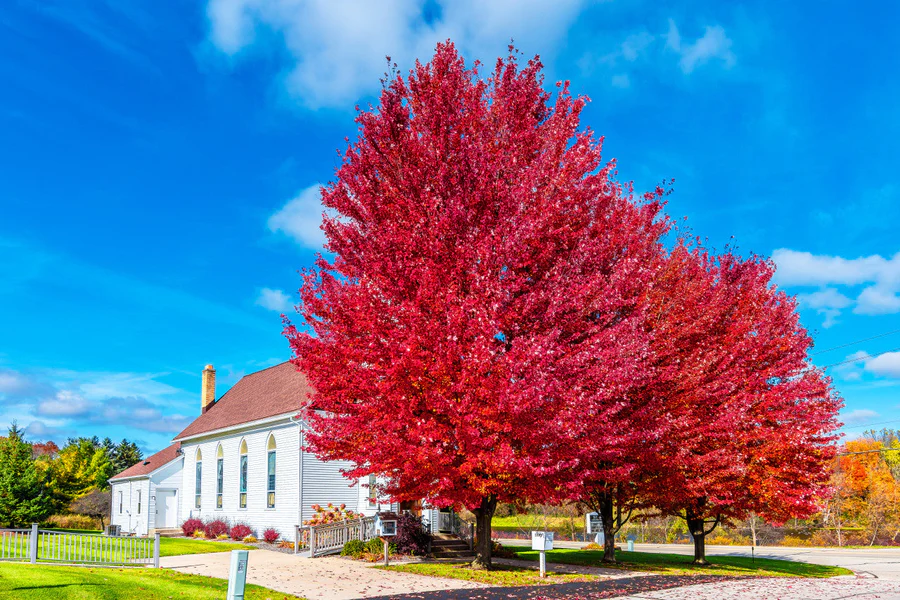Climate change is warming Autumn and disrupting the annual display of those beautiful foliage colors.
“The beauty of fall foliage is a natural wonder that captivates people worldwide,” states Dennis Sons, Owner of TN Nursery in Altamont, Tennessee, a leading native tree nursery. As summer transitions into Autumn, deciduous trees shed their leaves each year, creating a breathtaking tapestry of vibrant colors.
This annual spectacle has become a cherished part of many cultures, drawing tourists and locals alike to witness the stunning transformation of landscapes.
However, the awe-inspiring fall foliage faces a growing threat from climate change. Rising temperatures, shifting weather patterns, and altered ecosystems disturb this natural phenomenon’s delicate balance. This article will explore how climate change disrupts fall foliage, examining the various impacts and discussing potential adaptations to mitigate these effects.
The Science Behind Fall Foliage
Before delving into the impact of climate change, it is essential to understand the science behind fall foliage. The brilliant colors of autumn leaves result from a complex interplay of environmental factors and biological processes. Here’s how it works:
Pigments:
The green color of leaves during the growing season is primarily due to chlorophyll, a pigment critical for photosynthesis. Trees receive signs to prepare for winter as days grow shorter and temperatures drop in the fall. In response, chlorophyll production decreases, making other pigments in the leaves more visible.
Carotenoids:
These pigments, including beta-carotene, are responsible for leaves’ yellow and orange hues. Carotenoids are present in leaves throughout the year but are overshadowed by chlorophyll during the growing season.
Anthocyanins:
These red and purple pigments are not always present in leaves but are produced under certain conditions. They require cool, sunny autumn days and cold nights to develop. Anthocyanins are responsible for the vibrant reds and purples in fall foliage.
Combining these pigments and their interactions gives rise to the spectacular colors that define fall foliage. However, climate change is disrupting this delicate process.
Impact of Climate Change on Fall Foliage
Warmer Temperatures:
One of the most significant impacts of climate change on fall foliage is the rise in temperatures. Warmer autumns delay the onset of the color-changing process. With higher temperatures persisting into late fall, chlorophyll remains active for extended periods, masking the display of other pigments. As a result, the vivid colors associated with fall foliage appear later and may be less intense.
Drought Stress:
Climate change can lead to more prolonged and severe droughts, which can stress trees. In drought, trees may shed their leaves prematurely as a survival strategy, causing the fall foliage season to be shorter and less vibrant.
Altered Precipitation Patterns:
Changes in precipitation patterns can also affect fall foliage. Insufficient moisture can lead to stressed trees and shorter foliage seasons. Conversely, excessive rain can wash away leaves prematurely, disrupting the display.
Increased Pests and Diseases:
Rising temperatures can contribute to the proliferation of pests and diseases that affect trees. Infested or diseased trees may display brown, withered leaves instead of the vibrant colors associated with healthy foliage.
Shifting Geographic Ranges:
As a result of climate change, the geographical distribution of tree species can be altered. Certain tree species may migrate towards the north or higher elevations as temperatures rise for suitable environmental conditions. This can alter the composition of forests and impact the types of trees contributing to fall foliage displays.
Unpredictable Weather Events:
Climate change has led to more extreme and unpredictable weather events, such as late-season storms and unseasonal warm spells. These events can damage or prematurely dislodge leaves, disrupting the fall foliage display.
Impact:
While climate change poses significant challenges to fall foliage, there are several potential adaptations and strategies to mitigate its effects:
Preserve Natural Habitats:
Conserving natural habitats and protecting tree species from deforestation and urbanization can help ensure that diverse and healthy tree populations continue contributing to fall foliage displays.
Reforestation:
Planting native tree species in areas where they have been lost can aid in preserving the fall foliage tradition. These newly planted trees can adapt to changing conditions and contribute to future displays.
Select Resilient Tree Species:
Landscapers and urban planners can select tree species better suited to withstand changing climate conditions. These species may be better equipped to maintain their vibrant fall colors even in warmer and drier autumns.
Water Management:
Implementing water management strategies, such as mulching and proper irrigation, can help alleviate drought stress and ensure trees retain their leaves for extended periods.
Education and Advocacy:
Making sure there is adequate awareness about the major impact of what climate change has on autumn leaves and promoting sustainable practices can foster a deeper appreciation for nature and inspire action.
Phenology Monitoring:
Tracking the timing of leaf color changes and sharing data through citizen science initiatives can help scientists and conservationists understand how climate change affects fall foliage and make informed decisions about conservation efforts.
Conclusion
Fall foliage is a natural marvel that has captivated generations with its vibrant colors and seasonal beauty. The beauty of nature and tree foliage changing colors is highly valued, but unfortunately, climate change poses a significant threat to this beloved phenomenon.
Rising temperatures, shifting weather patterns, and altered ecosystems disrupt the delicate balance of fall foliage, leading to delayed and less vibrant displays. To mitigate these effects, it is essential to take action to preserve natural habitats, select resilient tree species, and raise awareness about the impact of climate change.
By making these adaptations, we can help ensure that the stunning beauty of autumn foliage can be enjoyed by future generations.






